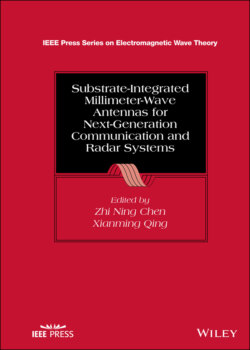Читать книгу Substrate-Integrated Millimeter-Wave Antennas for Next-Generation Communication and Radar Systems - Группа авторов - Страница 26
1.6.1 Fabrication Processes and Materials of the Antennas
ОглавлениеWith the shorter operating wavelengths in the order of a millimeter, the fabrication of mmW antennas needs a tolerance usually tighter than microwave to achieve the desired performance. For example, for a straight thin half‐wave dipole antenna operating at 60 GHz, the overall length of the antenna is about 2.5 mm. The acceptable fabrication tolerance is typically 0.2% wavelength, namely 0.05 mm, which nearly reaches the limit of the conventional commercial PCB process. The tighter tolerance of fabrication is needed if the antennas and feeding network are printed on the PCBs with the relative dielectric constant larger than unit. Therefore, the selection of fabrication for mmW antennas with feeding networks is more critical than that at lower microwave bands, not only because of the tolerance but also costs including processing, materials, and assembling.
At the mmW bands, multilayered substrates such as polytetrafluoroethylene (PTFE), a synthetic fluoropolymer of tetrafluoroethylene, and PTFE composite filled with random glass or ceramic such as RT/duroid® are commonly used for laminating circuits and antennas. PTFE‐based substrates usually feature a low and stable loss tangent typically of 0.0018 at 10 GHz and even higher and high resistance to chemical processing and are waterproof and thermally stable. PTFE‐based substrates, however, suffer from a higher cost compared to FR4 glass epoxy, are softer materials, and have a higher thermal expansion coefficient. FR4 glass epoxy is most commonly used in frequencies lower than 3 GHz because of its increasing loss tangent against frequency.
LCPs are a class of aromatic polymers. The unique feature of the LCP substrate is its softness although it has similar properties to PTFE‐based substrates such as extreme chemical resistance, high mechanical strength at high temperatures, and inertness. Its poor thermal conductivity and surface roughness should be taken into account in electrical applications, in particular, at mmW bands.
To meet the requirements of fabrication tolerance, electrical, and other mechanical properties, low temperature co‐fired ceramic (LTCC) has long been used as a cost‐effective substrate technology in electrical and electronic engineering, especially at higher frequencies. LTCC is a multilayered glass ceramic substrate. It is co‐fired with low‐resistance metal conductors, such as Au or Ag, at low firing temperatures, usually ∼850–900 °C, compared with high temperature multilayered ceramic sintered at ∼1600–1800 °C. There have been many ceramic materials developed by commercial companies. More detailed information can be found in the book [28], which studies a variety of electrical materials for mmW applications. In particular, the information about the ceramic materials used in LTCC is comprehensive.
For example, Ferro A6M has been widely used in applications at mmW bands. It has a relative dielectric constant of 5.9–6.5 and loss tangent of ∼0.001–0.005 at 3 GHz. In particular, the electrical properties are stable against frequency. The relative dielectric constant and loss tangent of DuPont 951 ceramic are ∼7.85 and 0.0063 at 3 GHz, respectively. It should be noted that the ceramic used in LTCC usually has the relative dielectric constants of ∼6–10, sometimes ∼18 [29]. High relative dielectric constants are usually not desired for antenna design at mmW bands because they will shrink the dimensions of antennas so that the fabrication needs much higher accuracy [30].
With an LTCC process, the LTCC ceramic substrate can host almost an infinite number of layers. The thin layers are stacked one on the top of another. The conducting paths of gold or silver thick film pastes are printed on each surface layer by layer using the silk‐screen printing method. When the multilayer setup has been stacked and printed, it is then fired in the process oven where the low sintering temperature allows the use of gold and silver as conducting traces. The simplified description of process includes:
Step I: via punch, via conductor fill, and trace printing;
Step II: layer stack and lamination; and
Step III: layer co‐fire.
The PCB and LTCC processes are concisely compared in Figure 1.5. From a waveguide feeding network and antenna design point of view, the most important difference between the PCB and LTCC processes is that the LTCC process is able to implement the blind via and embedded cavity while the PCB process is unable to do it.
Furthermore, the LTCC used for SIA designs also increases the advantages such as low loss tangents, low permittivity tolerance, good thermal conductivity, multilayered substrate, cavities/embedded cavities, low material costs for silver or gold conductor paths, easy integration with other circuits, and low production costs for medium and large quantities.
In our experience, the PCB process is preferred for SIA designs when an operating frequency is lower than 60 GHz, while LTCC is a good candidate antennas operating at frequencies higher than 60 GHz and up to 300 GHz. At frequencies higher than 300 GHz, the LTCC fabrication becomes quite challenging because of its process limit such as via‐hole pitch.
